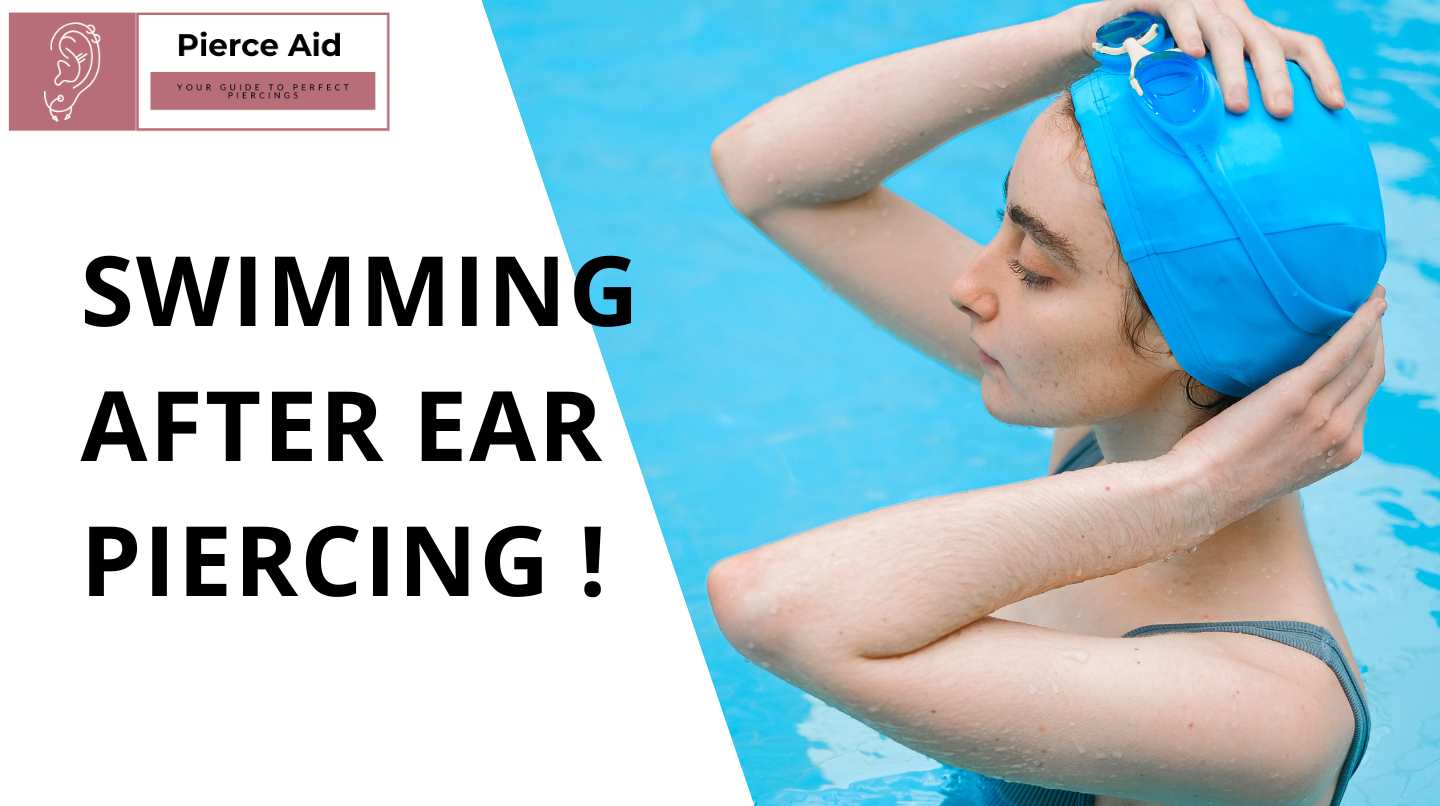Getting a new ear piercing is always exciting, but many people have the same question: when is it safe to go swimming after an ear piercing?
Whether you’re eager to jump back into the pool, take a dip in the ocean, or cool off in a lake, it’s essential to understand the risks and take extra precautions to avoid infections. Swimming too soon after a piercing can expose your healing ear to bacteria and chemicals that may cause complications.
In this blog, we’ll cover how long you should wait before swimming, the risks of getting your piercing wet too early, and tips on protecting your ear piercing while swimming to ensure a smooth healing process.
Key Takeaways:
- It’s generally recommended to avoid swimming after an ear piercing for at least 4-6 weeks to reduce the risk of infections and allow your piercing to heal properly.
- Swimming pools, oceans, and lakes can contain bacteria and other contaminants that may irritate or infect a healing ear piercing.
- If swimming is unavoidable, discover the best ways to protect your ear piercing from water exposure, and learn how to properly clean and care for it afterward to prevent complications.
How Long Should You Wait Before Swimming After an Ear Piercing?

The general recommendation for anyone with a new ear piercing is to avoid swimming for at least 4-6 weeks. This waiting period gives your piercing time to heal and reduces the risk of infection from waterborne bacteria found in pools, oceans, or lakes. Exposing your piercing to water too soon can irritate the healing tissue and lead to complications, such as infections or delayed healing.
It’s important to note that the healing time may vary depending on the type of piercing. Lobe piercings tend to heal faster, usually within 6 weeks, while cartilage piercings take longer—sometimes up to 3-6 months. Regardless of the type, it’s crucial to give your ear sufficient time to heal before submerging it in water.
By waiting the recommended amount of time, you can help ensure your piercing heals properly and minimize the risk of infection, allowing you to enjoy swimming worry-free.
Why Is Swimming Right After a Piercing Risky?
Swimming too soon after getting an ear piercing can expose your fresh piercing to various risks, primarily due to the bacteria and chemicals present in different water sources. Here’s why it’s important to avoid swimming after an ear piercing until it has healed:
Risk of Infection:
Whether you’re swimming in a pool, the ocean, or a lake, all water sources contain bacteria that can easily irritate and infect a fresh ear piercing. Pools, oceans, and lakes aren’t sterile environments, and even small amounts of bacteria can enter the piercing site, leading to infections that can slow down the healing process or cause more serious complications.
Chlorine in Pools:
Chlorinated water, commonly found in swimming pools, is known to dry out the skin and the area around your ear piercing. Chlorine can strip your skin of its natural oils, causing irritation and prolonging the healing process. Additionally, chlorine can weaken the healing tissue, making your piercing more susceptible to infection.
Ocean Water:
While saltwater is often seen as a natural healer, ocean water still contains bacteria that could cause an infection in a healing ear piercing. The combination of salt, bacteria, and other pollutants in the ocean can pose a risk to your piercing, making it important to avoid swimming in the sea during the early stages of healing.
Lakes and Rivers:
Freshwater sources such as lakes and rivers often contain higher levels of bacteria, especially from natural organisms, algae, or human activity. These environments are among the riskiest places to swim with a fresh ear piercing because the chance of developing an infection is much higher due to the bacteria levels in the water.
It’s important to wait until all these signs are present before changing your jewelry, as rushing this process can lead to infections, irritation, or delayed healing. Even if the piercing looks healed on the surface, it’s essential to ensure the internal tissue has also recovered.
For some piercings, like cartilage piercings, healing can take months, so it’s best to consult your piercer if you’re unsure about the status of your piercing. Patience is key for a successful recovery and safe jewelry change.
What Happens If You Swim Too Soon?
Infections:
Swimming in pools, oceans, or lakes exposes your healing ear piercing to bacteria and contaminants that can easily enter the piercing site. This can cause an infection, which typically presents as redness, swelling, tenderness, or discharge around the piercing. In severe cases, the infection may require medical treatment or even force the piercing to close.
Delayed Healing:
Constant exposure to water, especially chlorinated or bacteria-filled water, can interfere with the body’s natural healing process. When your ear piercing is repeatedly exposed to moisture, it slows down the rate at which the tissue repairs itself, potentially prolonging the healing time. Delayed healing also increases the risk of further complications, such as scarring or persistent irritation.
Piercing Closure:
If your ear piercing becomes irritated or infected from swimming too soon, the piercing site may close prematurely. When the piercing is inflamed or swollen, the body might react by attempting to close the hole as part of the healing process. In some cases, this could mean that you need to have the area re-pierced once the infection clears up, which can be painful and inconvenient.
Piercing Healing Time
One of the most common concerns people have is how long it will take to heal. Read this guide, we’ll walk you through the healing timeline of eyebrow piercing, provide essential aftercare tips, and highlight signs to watch for to avoid complications during the healing process.
How to Protect Your Piercing If Swimming Is Unavoidable?
Although it’s best to avoid swimming after getting an ear piercing, there may be times when it’s unavoidable. If you find yourself in this situation, taking extra precautions can help protect your healing piercing from water exposure and reduce the risk of infections.
Here are some ways to keep your ear piercing safe while swimming:

Waterproof Bandages:
One of the most effective ways to protect your ear piercing is by using a waterproof bandage or cover. These bandages are designed to seal off the area and prevent water from entering the piercing site. Make sure the bandage is secure and covers the entire piercing before getting into the water. It’s also a good idea to have a few extra bandages on hand in case one becomes loose during your swim.
Swimming Cap:
Wearing a snug swimming cap can provide additional protection by helping to keep water out of your ears. A well-fitted swimming cap covers your ears and helps prevent your ear piercing from coming into direct contact with the water. While it’s not a foolproof method, it can reduce the likelihood of water reaching your piercing.

Avoid Submerging Your Head:
If possible, avoid fully submerging your head while swimming. Keeping your head above water minimizes the chances of your ear piercing being exposed to bacteria or chemicals in the water. If you must swim, try to limit the amount of time your piercing is underwater to further reduce the risk of irritation or infection.
Post-Swimming Care for Your Ear Piercing
Swimming After An Ear Piercing
If you’ve had to swim after getting an ear piercing, it’s crucial to follow a proper aftercare routine to prevent any potential complications. Here’s how to take care of your piercing after being in the water:
Clean Immediately After Swimming:
As soon as you’re done swimming, rinse your ear with fresh, clean water to remove any chlorine, salt, or bacteria that may have come into contact with your ear piercing. Follow up by using a sterile saline solution to thoroughly clean the piercing site. This will help flush out any debris or bacteria, reducing the risk of infection.
Pat Dry:
After cleaning, gently pat the area dry with a clean towel or tissue to avoid moisture buildup around the piercing. Make sure not to rub or irritate the ear piercing, as this can disrupt the healing process. Keeping the piercing dry is essential to prevent bacteria from thriving in the moist environment.
Monitor for Signs of Infection:
After swimming, it’s important to keep an eye on your ear piercing for any signs of infection. Watch for symptoms like redness, swelling, tenderness, or discharge around the piercing site. If you notice any of these signs, consult your piercer or a healthcare provider as soon as possible. Addressing an infection early can prevent more serious complications and ensure your piercing heals properly.
Conclusion

Although swimming is off-limits for the first few weeks after getting an ear piercing, the wait is well worth it to ensure a safe and smooth healing process. Giving your piercing the necessary time to heal will help you avoid potential sources of infection and complications caused by bacteria in pools, oceans, and lakes.
By following proper aftercare guidelines and waiting the recommended 4-6 weeks before swimming, you can enjoy your new ear piercing without any issues.If swimming becomes unavoidable, take precautions to protect your piercing, such as using waterproof bandages or wearing a snug swimming cap.
Additionally, always clean your ear piercing immediately after swimming to minimize the risk of irritation or infection. With the right care, you’ll be able to enjoy both swimming and your new piercing safely.
Frequently Asked Questions:-
-
How long should I wait to swim after getting an ear piercing?
It’s recommended to wait at least 4-6 weeks before swimming after getting an ear piercing to allow the piercing to heal and reduce the risk of infection.
-
What happens if I swim too soon after an ear piercing?
Swimming too soon can expose your piercing to bacteria, potentially causing infections, delayed healing, or even closure of the piercing.
-
Can I swim with an ear piercing if I cover it?
Yes, you can reduce the risk by using waterproof bandages or wearing a snug swimming cap to help protect your ear piercing from water exposure. However, it’s still best to avoid swimming until the piercing is fully healed.
-
Is it safe to swim in the ocean after getting an ear piercing?
While ocean water contains salt, it also contains bacteria and pollutants that can cause infections in a healing ear piercing. It’s best to avoid ocean swimming during the healing process.
-
Can chlorine from pools affect my ear piercing?
Yes, chlorine can irritate your ear piercing, dry out the skin, and delay healing. Chlorinated water can also harbor bacteria that may cause infections.
-
How should I clean my ear piercing after swimming?
After swimming, rinse your ear piercing with fresh, clean water and follow up with a saline solution to clean the piercing and remove any bacteria or chemicals.
-
What are the signs of an infection in my ear piercing after swimming?
Signs of infection include redness, swelling, tenderness, and discharge from the piercing site. If you notice any of these symptoms, consult your piercer or a healthcare provider.
-
Can I swim in a lake or river after getting an ear piercing?
Lakes and rivers often contain higher levels of bacteria, making them riskier for a healing ear piercing. It’s recommended to avoid swimming in freshwater sources until your piercing is fully healed.

